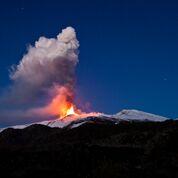MOTHER EARTH RUMBLES
Mount Etna: When Mother Nature rumbles
Pele, the Hawaiian goddess of fire, is at work when Kīlauea yields its fiery lava. According to the ancient Greeks, Atlantis was sunk by the gods during a terrible night of earthquakes and fire. Sparks flew from Mount Etna when Vulcan, the Roman god of fire, was angry. The world takes notice when Mother Nature speaks. One of the most active volcanos on the earth, Mount Etna, is a spectacular place to visit for scientists and tourists alike who are looking to see the forces of nature at work. And while the unfortunate eruption at Mount Stromboli makes residents and tourists fearful, there are many reasons to continue to explore Etna.
What makes Etna and Stromboli different is type of activity these two volcanoes display. “Stromboli has been erupting continuously for thousands of years,” says Hubert Staudigel, a Volcanologist at UC San Diego. “The Romans called it the lighthouse of Naples, because they could navigate by the glowing lava coming out pretty constantly day and night. Very small quantities of lava come out with each little burst, but it shows that the vent to the Stromboli magma chamber is open all the time. That means it never builds up much pressure preventing cataclysmic eruptions. Also, the constant small eruptions make enough seismic noise that it is hard to predict somewhat (very rare) bigger eruptions like the one happening recently.”
Volcanoes remind us of the primordial forces at work in the world we live in, which make them both fascinating and frightening. While the Stromboli eruption was unexpected, there are ways scientists monitor volcanoes. In Italy, the National Institute of Geophysics and Volcanology (INGV) carries out research, monitoring and surveillance and notifies government and the public of significant activity. Dr. John Murray of Open University has been studying Etna for over 50 years. He and his colleagues recently published their findings that Etna was sliding downward, an event slow in process but something that needs monitoring. “I would say there is currently no cause for alarm, but it is something we need to keep an eye on, especially to see if there is an acceleration in this motion,” Dr John Murray told BBC News.
And while events like the Stromboli eruption are unpredictable, Cultural Italy relies on the expertise from the nature guides on Etna. These experts get their information directly from the Visitor’s Center on Etna, which provides educational and research services to tourists and scientists and is open year-round. Spanning over 25 miles, Etna has many trails in non-active areas. At different times of the year, the mountain may have snowfall and if lava is actively flowing in different areas, the experts know where to safely observe. There is a range of free learning courses about volcanoes on The Open ¬University’s website www.open.edu/openlearn or visit the Etna Visitor’s Center website at www.parcoetna.it.
Jennie Olson Six
Palmer, Jane “Why Ancient Myths about Volcanoes are often true”, BBC News Online 3/18/2015 http://www.bbc.com/earth/story/20150318-why-volcano-myths-are-true 7/9/2019
Amos, Jonathan “Mount Etna is ‘sliding towards the sea’”, BBC News Online 3/24/2018 https://www.bbc.com/news/science-environment-43522169 7/9/2019


